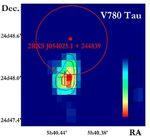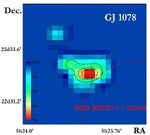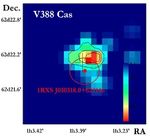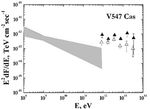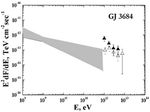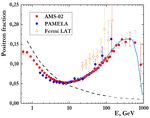Red Dwarfs as Sources of Cosmic Rays - EPJ Web of ...
←
→
Page content transcription
If your browser does not render page correctly, please read the page content below
EPJ Web of Conferences 260, 11033 (2022) https://doi.org/10.1051/epjconf/202226011033
NIC-XVI
Red Dwarfs as Sources of Cosmic Rays
Vera Yu. Sinitsyna1,∗ , Vera G. Sinitsyna1,∗∗ , and Yurii I. Stozhkov1
1
P.N. Lebedev Physical Institute, Moscow, Russia
Abstract. The Pamela, Fermi, AMS-02 spectrometer experimental data cannot
be explained using the diffusive models of propagation of cosmic-rays accel-
erated at the supernova shocks and require the existence of nearby sources of
cosmic rays at the distances less than one kpc. These sources could explain the
growth of the ratio of galactic positrons to electrons with an energy increase, the
complex dependence of the exponent of the proton and alpha spectra on the en-
ergy, the cosmic ray anomaly component origin. We consider active dwarf stars
as possible sources of galactic cosmic rays in the energy range up to ∼ 1014 eV.
The generation of high-energy cosmic rays should be accompanied by high-
energy gamma-ray emission, which may be detected. The TeV gamma-ray
emission mostly of flaring type from active red dwarf stars V388 Cas, V547 Cas,
V780 Tau, V962 Tau, V1589 Cyg, GJ 3684, GJ 1078 and GL 851.1 was de-
tected recently with SHALON long-term observations. This result confirms
that active dwarf stars are also the sources of high-energy galactic cosmic rays.
1 Introduction
Supernova explosions are considered as sources of Galactic cosmic rays. Indeed, investi-
gations of last years show that the Supernova Remnants (SNRs) are powerful accelerators of
cosmic-ray particles up to ∼ 1017 eV. But, the proton and helium spectra at high and very high
energies measured by PAMELA and AMS-02 can’t be explained using the diffusive models
of propagation of supernova shock born cosmic-rays. Also, there is no explanation of the ex-
cess of 10 - 300 GeV positron flux detected by PAMELA and AMS-02 experiments (Fig. 1).
An interpretation of all these observations hints at a presence of nearby sources of cosmic
rays at the distances less than 1 kpc from the solar system. We consider active dwarf stars as
possible sources of galactic cosmic rays with energies up to ∼ 1014 eV whose generation is
accompanied by the X-ray and high-energy γ-ray emission including TeV-energy range.
2 On red dwarf stars
The dwarf stars belong to the G - M classes of the main sequence of stars and are more than
90% of all 2 × 1011 stars in our Galaxy. The nearest of the dwarf stars are at several parsecs
from Earth and are uniformly distributed inside of the galactic disc [1]. These stars produce
powerful stellar flares, which sometimes occur several times per day, but its flare frequency
is uncertain. The total energy release estimates as 1034 − 1036 ergs [1, 2]. The total energy of
cosmic rays produced by the dwarf star flares in the Galaxy is estimated as ≈ 1051 − 1053 ergs
[3]. This could provide the amount of energy of charged cosmic rays in our Galaxy compared
with ones from SN explosions. If active dwarf stars produce cosmic rays with E ≤ 1014 eV,
it can explain the anomalies detected by PAMELA, AMS-02, CALET, DAMPE [4, 5].
∗ e-mail: sinicinavy@lebedev.ru
∗∗ e-mail: sinits@sci.lebedev.ru
© The Authors, published by EDP Sciences. This is an open access article distributed under the terms of the Creative
Commons Attribution License 4.0 (http://creativecommons.org/licenses/by/4.0/).EPJ Web of Conferences 260, 11033 (2022) https://doi.org/10.1051/epjconf/202226011033
NIC-XVI
Figure 1. The ratio of e+ flux to the sum of e− and e+ fluxes
versus energy of these particles. Blue points are the PAMELA
data and red points are the AMS-02 data. Dashed line shows
model predictions from [10]. Blue line shows the result of
calculations of ratio fluxes of e+ to (e+ + e− ) versus energy if
the probability of positron release from stellar flare site is taken
into account.
3 Very high energy emission of red dwarf stars
TeV γ-ray emission from the M-stars was detected in SHALON experiment [3] on the level
of > 5σ and the average fluxes shown in Table 1. During the long-term observations of red
dwarfs the flux variations of at energies up to 10 TeV were detected. Both, average (△) and
flaring (▲) spectral energy distributions (SED) are presented in Fig. 2. The energy spectrum
shapes at E > 800 GeV can be fitted with a soft power law: dF/dE ∝ E k , the details are listed
in Table 1. The duration of high flux periods corresponding to the flare spectra was found to
befrom 2 to 5 days [3]. The detected TeV γ-ray fluxes show that these objects produce flares
with a total energy of ∼ 1034 − 1035 ergs. But, the most powerful solar flare is 1032 ergs.
The searches for counterparts for the detected at TeV energy M-stars in X-rays and MeV-
GeV energies were performed. X-ray emission from the position of these objects was de-
tected by ROSAT . In Fig. 2 the emission maps of listed red dwarfs by SHALON in compar-
ison with data from X-ray data are presented. The X-ray emission (0.1 - 2.4 keV) from the
position of discussed red dwarfs (error ∼ 10′′ ) was detected with ROSAT with energy fluxes
from 3.9 × 10−13 to 2.5 × 10−12 erg cm−2 s−1 and indexes of ∼ −2. It corresponds to the
estimated luminosity of from 5 × 1027 to 1 × 1029 erg s−1 . High-energy emission from unas-
sociated sources at distances of < 0.6◦ from V962 Tau, V1589 Cyg, GJ 1078 and GL 851.1
were also detected by Fermi LAT. The spectra of each of unassociated objects are presented
in Fig. 2 with bow tie and is consistent with SHALON data for these red dwarfs at TeV en-
ergies. Unfortunately, V388 Cas, V547 Cas, V780 Tau and GJ 3684 were not active enough
after 2008 to produce a significant detection by Fermi LAT launched in 2008. But, V1589
Cyg, V962 Tau, GJ 1078, GL 851.1 were quite active during the whole period of observations
and the nearby Fermi LAT unassociated sources may actually be these red dwarfs.
4 Discussion
The discovery of flaring red dwarf stars at E ≈ 1 ÷ 20 TeV by SHALON, confirms, that these
stars are also the sources of high energy cosmic rays and can explain a number phenomenon
viewed in space experiments. The space experiments in the energy range from ∼ 50 GeV up
to several hundreds of GeV show that the spectra of protons and α-particles do not follow
single power law with constant exponent γ [5, 7]. If galactic cosmic rays are produced by
shock-waves from supernova explosions and cosmic ray life-time in Galaxy is about 106 −108
years the diffusion process smooths the spectra of these particles. As there are many active
dwarf stars nearby the solar system and their stellar activity is quasi-periodic, one can expect
Table 1. Red stars of Flare star catalogue [1] viewed by SHALON.
Here a Integral flux at energy > 800 GeV in units of 10−12 cm−2 s−1 and
b
Index in fitting of TeV differential spectrum in form of power low dF/dE ∝ E kγ and dF/dE ∝ E kFlare )
Source Distance, Spectral F(> 0.8 TeV)a kγb kbFlare
pc type
V388 Cas 10.5 M5V 0.84 ± 0.20 −2.51 ± 0.15 −2.91 ± 0.18
V547 Cas 10.1 dM2.5e/M2V 0.14 ± 0.03 −2.41 ± 0.29 −2.12 ± 0.32
V780 Tau 10.4 m/M5.5 or M7V 0.23 ± 0.03 −2.52 ± 0.15 −3.01 ± 0.21
V962 Tau - - 0.39 ± 0.04 −2.54 ± 0.16 −2.95 ± 0.22
V1589 Cyg 23 - 32 dM4.5e 0.13 ± 0.02 −2.91 ± 0.18 −3.15 ± 0.29
GJ 1078 20.6 M4.5V 0.38 ± 0.14 −2.46 ± 0.48 −3.11 ± 0.49
GJ 3684 16.5 m/M4V 0.33 ± 0.11 −2.64 ± 0.27 −3.04 ± 0.26
GL 851.1 21.7 dM0e or K5V 0.55 ± 0.09 −2.54 ± 0.42 −2.32 ± 0.21
2EPJ Web of Conferences 260, 11033 (2022) https://doi.org/10.1051/epjconf/202226011033
NIC-XVI
Figure 2. SEDs of red dwarfs by SHALON and Fermi LAT; Emission maps of red dwarfs by SHALON.
that the value of exponent γ may change if one or several such stellar objects are at the
distances of several pc from the Sun.
Another problem could be explained with nearby cosmic ray sources is so-called anomaly
component consisting of single ionized atoms like He, N, O, Ne, C, Mg, Si and others [8, 9]
with energies from ∼ 5 to 100 MeV/nucleon. The anomaly component has a positive radial
gradient in the heliosphere and undergoes a solar modulation. The mechanism of anomaly
component production was proposed in [9] but the spacecraft Voyager-1, 2 did not confirm
it. These single ionized atoms could be formed in flares of active dwarf stars if they are near
the solar system. These single ionized atoms will be totally stripped if the ionization cross-
section of σ ≈ 10−18 cm2 and the amount of interstellar matter between their source and the
solar system is ≥ 1. The interstellar medium density near Sun is about ρ ∼ 0.02 atom/cm3 .
Thus, the distance between the source and the solar system is L ≤ 1/(ρσ), i.e. L ≤ 30 pc, and
there are about 560 flaring red dwarf stars within the sphere of the ∼ 30 pc radius.
An important effect, discovered by the PAMELA and confirmed by AMS-02, is positron
excess or unexpected positron fraction raise instead of decrease [10]. The observed positron
fraction is starting to increase at ∼ 5 GeV and then monotonically grows up to ∼ 350 GeV,
then at energies > 500 GeV it falls down. A possible interpretation of this effect may in-
volve the active dwarf stars as the sources of cosmic rays up to E ∼ 1013 eV [6] This new
type sources of cosmic rays provides essential addition positron flux to one produced in the
interstellar medium in interactions of cosmic rays with interstellar matter. (see line in Fig. 1).
References
[1] R.E. Gershberg et al., Astron. Astrophys. Suppl. Ser. 139, 555 (1999)
[2] S. Ohm & C. Hoischen, MNRAS 474, 1335-1341 (2018)
[3] V.G. Sinitsyna, V.Y. Sinitsyna, Y.I.Stozhkov, Adv. Space Res. 64(12), 2585-2594 (2019)
[4] O. Adriani, G.C. Barbarino, G.A. Bazilevskaya et al., Nature 458(7238), 607-609 (2009)
[5] M. Aguilar, D. Aisa, B. Alpat et al., Phys. Rev. Lett. 114, 171103 (2015)
[6] Yu.I. Stozhkov, Bull. of RAS ser. Physics 75(3), 323-326 (2011)
[7] O. Adriani et al., Rivista del Nuovo Cimento 40(10), 473-522 (2017)
[8] M. Garcia-Munoz, G.M. Mason, J.A. Simpson, Astrophys. Journ. Lett. 182, L81 (1973)
[9] L. Fisk, B. Kozlovsky, R. Ramaty, Astrophys. Journ. Lett. 190, L35 (1974)
[10] I.V. Moskalenko & A.W. Strong , Astrophys. J. 493, 694-707 (1998)
3You can also read




